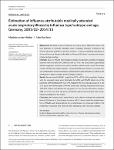Estimation of influenza-attributable medically attended acute respiratory illness by influenza type/subtype and age, Germany, 2001/02–2014/15
Heiden, Matthias an der
Buchholz, Udo
Background: The total burden of influenza in primary care is difficult to assess. The case definition of medically attended “acute respiratory infection” (MAARI) in the German physician sentinel is sensitive; however, it requires modelling techniques to derive estimates of disease attributable to influenza. We aimed to examine the impact of type/subtype and age. Methods: Data on MAARI and virological results of respiratory samples (virological sentinel) were available from 2001/02 until 2014/15. We constructed a generalized additive regression model for the periodic baseline and the secular trend. The weekly number of influenza-positive samples represented influenza activity. In a second step, we distributed the estimated influenza-attributable MAARI (iMAARI) according to the distribution of types/subtypes in the virological sentinel. Results: Season-specific iMAARI ranged from 0.7% to 8.9% of the population. Seasons with the strongest impact were dominated by A(H3), and iMAARI attack rate of the pandemic 2009 (A(H1)pdm09) was 4.9%. Regularly the two child age groups (0-4 and 5-14 years old) had the highest iMAARI attack rates reaching frequently levels up to 15%-20%. Influenza B affected the age group of 5- to 14-year-old children substantially more than any other age group. Sensitivity analyses demonstrated both comparability and stability of the model. Conclusion: We constructed a model that is well suited to estimate the substantial impact of influenza on the primary care sector. A(H3) causes overall the greatest number of iMAARI, and influenza B has the greatest impact on school-age children. The model may incorporate time series of other pathogens as they become available.
Dateien zu dieser Publikation
Keine Lizenzangabe

